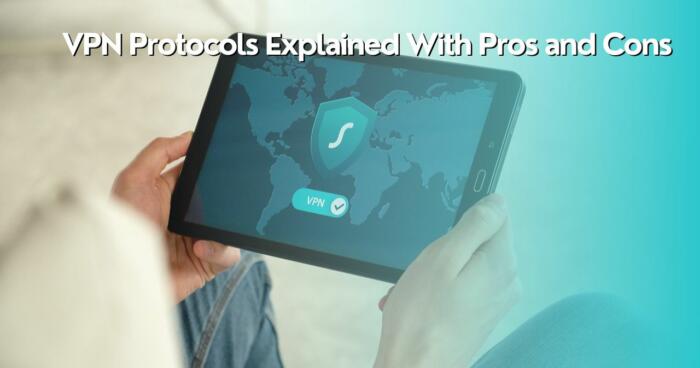A VPN routes your traffic through a secure tunnel using a variety of VPN protocols. These are sometimes called tunneling protocols, as they help transmit data packets through the tunnel and encrypt them. You’ve surely heard about OpenVPN, WireGuard, IKEv2, and others.
They exist for a reason, with notable differences in security, speed, performance, and stability. This begs the question of what these protocols are and their advantages and shortcomings. In today’s article, we’ll explain each popular protocol and see what they have to offer.
For those in a hurry, here’s a comprehensive overview of all protocols we analyzed, with their pros/cons.
|
Protocol |
Pros |
Cons |
|
OpenVPN |
Very secure Open-source Commonly compatible Great for firewall restrictions/censorship |
On the slower side Manual configuration can be complicated |
|
WireGuard |
Open-source Extremely fast Secure and safe Mobilefriendly with batterysaving ability Easy to maintain and improve |
Privacy concerns in the vanilla version of WireGuard Not great for getting over censorship |
|
IKEv2/IPSec |
Fast and stable Compatible with iOS Keeps the VPN connection on when switching between networks |
Not as compatible as OpenVPN Difficult or impossible to set up on some devices |
|
L2TP/IPSec |
Simple to set up Available for most devices Solid encryption |
Subpar performance Not great for firewall restrictions |
|
PPTP |
Fast for streaming and gaming Straight-forward setup Compatible with most devices |
Easy to breach Outdated |
|
SSTP |
Great security Bypasses firewalls Fast speed |
Incompatible with many platforms Closedsource |
|
Proprietary Protocols |
|
|
|
NordLynx |
One of the fastest protocols Fixed WireGuard’s privacy vulnerability Developed by NordVPN (with an audit) |
Available only in NordVPN |
|
Lightway |
Excellent performance Strong encryption Capable of beating firewalls Audited by Cure53 |
Only ExpressVPN offers it |
|
Hydra |
Good for bypassing censorship Stable performance |
No audits Offered by a handful of VPNs |
|
Stealth |
Works in China Obfuscation adds to the security |
Slower speed due to obfuscation |
What Are VPN Protocols?
So first, we need to establish the definition of a VPN protocol. Simply put, a VPN protocol is a set of procedures that determines how the data will be transferred between a VPN server and the device connected to it. To make it clear, all VPNs use encrypted tunnels for this transfer.
Yet, the procedure for establishing the connection is different and dictated by the VPN protocol. All protocols have advantages and shortcomings and none of them are perfect, as they focus on different aspects, such as privacy, speed, or reliability. Below, we explain each.
VPN Protocols Explained
On today’s menu, we have the six most popular VPN protocols to go through, they include:
OpenVPN
OpenVPN is the bread and butter of the VPN industry. Established more than 20 years ago, this is an open-source VPN protocol that accentuates security. Being open-source, users can inspect its source code and fix bugs and vulnerabilities to ensure it’s working properly.
Moreover, it’s compatible with a heap of devices and systems, making it a goto choice for systems like Windows, macOS, and Android, as well as devices like routers, Smart TVs, and other streaming devices. It uses AES256 encryption but it supports pretty much any encryption standard.
OpenVPN has UDP and TCP protocols, where UDP is more for speed, while TCP is focused on reliability and use in VPNrestricted conditions at the cost of slower speed. As a whole, OpenVPN isn’t the fastest and its setup from scratch can be complicated without a VPN client.
WireGuard
WireGuard is much newer than OpenVPN. It’s yet another open-source protocol developed for speed and short connection times. It’s less resourceintensive, as it contains fewer lines of code and is easier to maintain, upgrade, and fix if vulnerabilities are detected.
Like OpenVPN, WireGuard is extremely secure and works with multiple encryption standards. Another perk is excellent compatibility because WireGuard works with almost every device. Furthermore, as it’s not resourceintensive, it’s excellent for saving battery on mobile devices.
Almost all VPNs in 2025 use WireGuard as their primary protocols. Some even developed proprietary protocols based on WireGuard which we’ll discuss later in the article.
IKEv2/IPSec
IKEv2/IPSec is a combo of security and speed. Developed by Cisco and Microsoft, IKEv2 uses IPSec as an authenticator and encryption, while IKEv2 provides welloptimized performance. IKEv2 is mostly used on mobile devices – iOS, in particular – but it works on desktop systems too.
This protocol is often used instead of VPN for better speed and superior stability. However, compared to OpenVPN, its device compatibility isn’t the best, so outside of Windows/macOS and Android/iOS devices, it’s either impossible or very difficult to set up.
In general, IKEv2/IPSec relies on connection stability and reliability, thanks to MOBIKE support. Thus, on mobile devices, when you switch from mobile data to WiFi and vice versa, IKEv2 is known to preserve the VPN connection without exposing your IP address and sensitive data.
L2TP/IPSec
L2TP/IPSec is a rarely used VPN protocol nowadays. L2TP lacks encryption. It only connects you to the server and uses encryption and authentication from IPSec. Combined with IPSec, L2TP is a solid option for security and overall compatibility because it can work on a myriad of devices.
It’s not popular for a reason, though. Its performance is subpar and is on the slower side compared to other VPN protocols. Also, L2TP/IPSec is underwhelming for unblocking restricted sites and bypassing firewall restrictions, making OpenVPN a superior option.
PPTP
PPTP or (PointtoPoint Tunneling Protocol) was developed by Microsoft way back in the nineties. Its first use was for dialup internet connections. PPTP is extremely outdated and nonsupported by today’s VPNs because of its security vulnerabilities. Simultaneously, it’s also very fast.
That’s because it lacks strong encryption that would influence the performance. PPTP is suitable for lowlatency gaming or streaming and it’s easy to set up. On top of that, it’s compatible with most platforms.
SSTP
This is another Microsoft protocol and it stands for Secure Socket Tunneling Protocol. As expected, it’s developed primarily for Windows and focuses on speed, stability, and performance. By intertion, it’s less compatible with other platforms and works well only on Windows.
Security and encryption are strong and SSTP is also used to get over firewall restrictions. As it’s closedsource, SSTP can’t be improved and examined for security vulnerabilities. ExpressVPN used to offer SSTP before but nowadays, it’s hard to find in modern VPNs.
InHouse VPN Protocols
You’ll also see plentiful inhouse or proprietary VPN protocols such as:
- NordLynx (NordVPN)
- Lightway (ExpressVPN)
- Hydra (Hotspot Shield)
- Stealth (ProtonVPN)
We earn commissions using affiliate links.


![CyberGhost VPN Review: Features, Pros & Cons Explained [year] cyberghost vpn](https://www.privateproxyguide.com/wp-content/uploads/2021/03/cyberghost-vpn-150x150.jpg)
![HideMyAss VPN Review [year] Features, Pros & Cons Explained HideMyAss VPN Review 2021](https://www.privateproxyguide.com/wp-content/uploads/2018/06/hide-my-ass-review-homepage-150x150.jpg)
![Ivacy VPN Review [year] Features, Pros & Cons Explained ivacy vpn](https://www.privateproxyguide.com/wp-content/uploads/2021/03/ivacy-vpn-150x150.jpg)
![Hide.me VPN Review [year] Features, Pros & Cons Explained hide me](https://www.privateproxyguide.com/wp-content/uploads/2021/03/hide-me-150x150.jpg)
![Celo VPN Review [year] – Features, Pros & Cons Explained Celo VPN Review 2021](https://www.privateproxyguide.com/wp-content/uploads/2019/07/celo-vpn-review-150x150.jpg)
![Urban VPN Review [year] Features, Pros & Cons Explained urban vpn review](https://www.privateproxyguide.com/wp-content/uploads/2021/08/01-urban-vpn-home-page-150x150.jpg)
![SSLPrivateProxy Review: Features, Pros & Cons Explained [year] SSLPrivateProxy Review](https://www.privateproxyguide.com/wp-content/uploads/2020/09/sslprivateproxy-150x150.jpg)
![High Proxies Review [year] – Features, Pros & Cons Explained High Proxies Review](https://www.privateproxyguide.com/wp-content/uploads/2017/06/highproxies-150x150.jpg)
![VyprVPN Review - Features, Pros & Cons Explained [year] vyprvpn](https://www.privateproxyguide.com/wp-content/uploads/2021/03/vyprvpn-150x150.jpg)
![ezProxies Review [year] – Features, Pros & Cons Explained ezProxies Review](https://www.privateproxyguide.com/wp-content/uploads/2018/11/01-ezproxies-homepage-150x150.jpg)
![IDrive Backup Review: Features, Pros & Cons Explained [year] idrive](https://www.privateproxyguide.com/wp-content/uploads/2021/03/idrive-150x150.jpg)
![RoboForm Review: Features, Pros & Cons Explained [year] roboform](https://www.privateproxyguide.com/wp-content/uploads/2021/03/roboform-150x150.jpg)
![RememBear Review: Features, Pros & Cons Explained [year] RememBear Review](https://www.privateproxyguide.com/wp-content/uploads/2019/02/RememBear-Review-150x150.jpg)
![Dropbox Review: Features, Pros & Cons Explained [year] Dropbox review](https://www.privateproxyguide.com/wp-content/uploads/2020/04/Dropbox-150x150.jpg)
![Backblaze Review [year] Features, Pros & Cons Explained backblaze](https://www.privateproxyguide.com/wp-content/uploads/2021/03/backblaze-150x150.jpg)